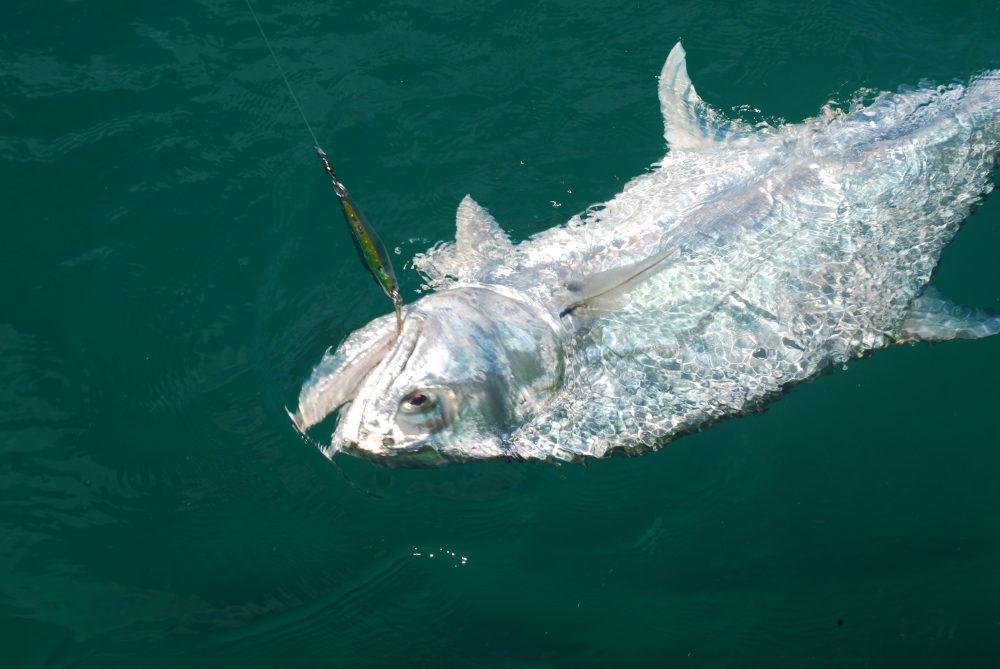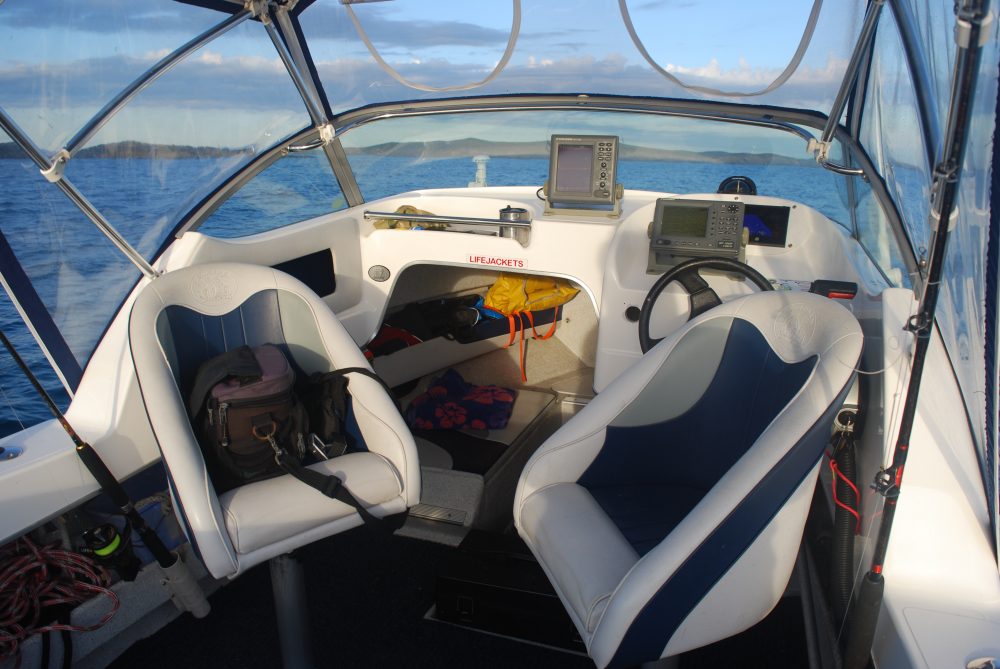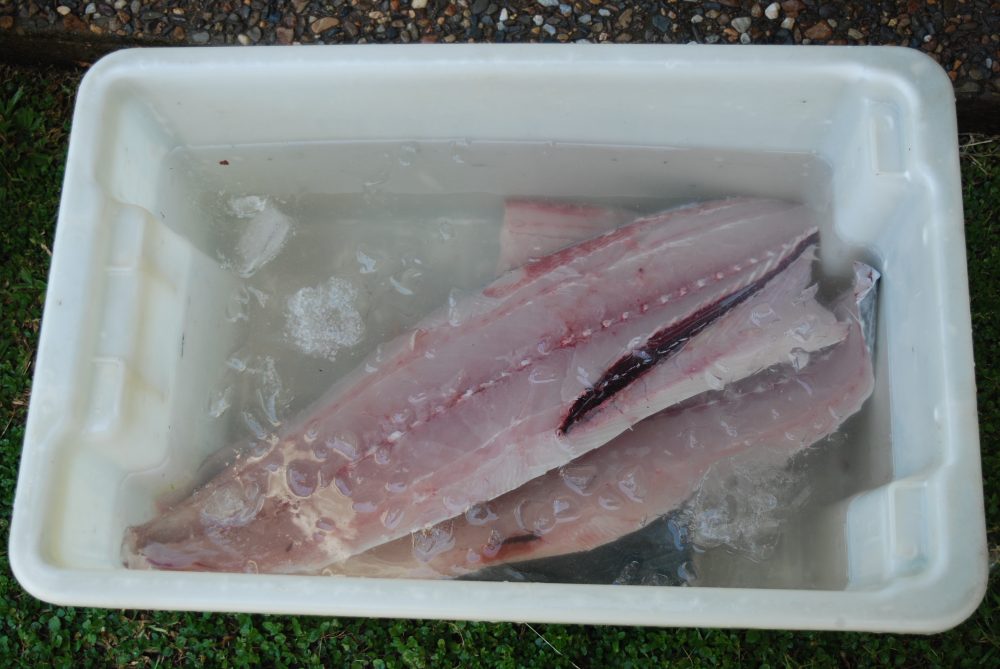Blue Tiger Spanish – By Bill Bowtell
It was dark, very dark. A light fog, the first for the season, drifted in from the southwesterly quarter and settled across the extent of the harbour. The only noise to be heard was the occasional “clanging” of sail ropes against the centre mast of the yachts, as they rolled at their marina moorings on the infrequent swells penetrating the harbour leads. I stood there and took it all in – the serenity, the casual sounds of harbour life, the lapping of the water against pylons and pontoons and the noise of baitfish being harassed as they gathered, attracted by the orbs of light thrown out by the gangway lights. It was kind of surreal. I was solitary – alone! But then, this was the middle of the COVID-19 lockdown, so understandable.
S-Cape 2 slid easily off the multi-rollered trailer – controlled all of the way by a fixed 1600kg “static” rope. It’s a relatively easy one-person operation when you get used to it. And certainly made easier by the lack of boats vying for a position either, at the top of the ramp or, squeezing in close by for a submerged trailer start-up. The prop wash under these circumstances makes for tricky boat control when it’s a one-person launch operation. This morning it was smooth to the max. S-Cape 2 was secured to the bollards of the pontoon. Her bow pointing towards the harbour leads. She was ready to go.
This was my first offshore trip since the big rains of February and early March and I wanted to check out Corio Heads to the north of Yeppoon, along with the inshore reefs and wrecks of that same area before heading wider in search of Spanish mackerel. I needed a feed and Spanish are my favorite eating fish. It had been a while.

A nice touch to the ice-box – three-and-a-half succulent Spanish mackerel – soon to be two-and-a-half!
The usual suspects were hanging around the rocky reefs and headlands of Corio Heads and Little Corio Heads. In the main they were Queenfish and trevally and were spread from the entrance of Corio Bay to beyond the northern headland of Little Corio Bay, the eastern facing beach between the headlands. The first Queenfish – a beauty of 1.23 metres, struck the 65grm Raider lure as it sped back towards S-Cape 2.
It was a deliberately placed cast: just to the south of the rocky reef located at the entrance to Corio Bay and, slightly seawards so as to land in the permanent gutter, which runs in a north-south direction past the reef. This particular area has produced many, and varied, fish and fish species over the years and it looked as if the fish were again on the prowl; chasing the bounty of bait produced in the bay following a bountiful and timely “wet”.
And whilst this Queenie was a great fish and offered wonderful sport (it was the largest I have ever caught by more than 100mm), it was not my main quarry, for I was here after “greys” – Grey Mackerel, or Broad Barred Mackerel, (Scomberomorus semifaciatus). These fish like nothing more than a well-presented “silver” lure and the locally produced, “Flasha” and the nationally produced, “Raider” are two of my most favoured “silver” lures for this species.

A big 1.23m Queenfish comes boatside in the green waters offshore of Corio Heads – Keppel Bay.
After the second Queenfish, a specimen of just under the metre mark, and then a giant trevally (Caranxignobilis) around the 48cm mark, it was time to move on. I thought to myself, “leaving fish to find fish, what a stupid idea!” On any other day I would have stayed. The fish were plentiful and they were there to feed. But, I too was after a feed, and Queenfish and trevally were not on the menu. But still, I laid out a final, “cursory”, exploring cast with a home-made popper, landing it just in behind the reef. The explosion of water as the big fish hit was immense.
Behind the reef I didn’t stand a chance. The culprit, a Queenfish well over the metre mark took to the air, stripped twenty metres of the 6kg Platypus mono from the Shimano TSS4 in five seconds flat, then dusted itself off on the northern section of rock. Gone!
An exciting interlude, for I had had that popper in my tackle box for almost 40 years! There was a pang of guilt for what seemed like total disregard for that old lure, but I was philosophical – “better to go down fighting, than to rot in an old tackle box.” Off to catch a Spanish!
Findlay Reef is situated at the northern end of Keppel Bay, midway along, and just south of a direct line between Corio Heads and Conical Rocks at the northern-most end of the Keppel Group of islands. At certain times of the year it fishes very well for Spanish mackerel. The months of March and April are two of those “certain times”, especially when there has been a good “flush” from the Corio Bay catchment. The presence of birds, terns and gannets in the main, are a good give away as to when the Spanish are present.
S-Cape 2 idled back as she came up onto the marks flashing on the screen of the Furuno chart plotter. A check of the sounder showed fish sitting off to the northeast of the seaward bommie. It was a strange formation, which showed as a horizontal “hourglass” pattern of bait with several large fish hovering both above and below the main patch of fish. I had only seen this once before and that was up at Cape Manifold. On that day the large fish were black king and whaler sharks. I decided to check out the current situation by working the Raider lure through the patch of fish whilst keeping a close eye on the sounder to note their reaction.

S-Cape 2 running a flat line wide of the nor-east corner of Outer Rock – Keppel Bay.
The bait split, then formed again. There was not a reaction from the larger fish. If they were black king then they were not biting.
The silver slither of a freshly rigged wolf herring slipped back beyond the Merc’s prop wash, by thirty metres. S-Cape2 was put on a course that would bring her in tight around the seaward bommies of the reef. On the turn the bait was taken – the fish took to the air, a bronze whaler of around the 1.6mmark. With my suspicions proven, it was time to leave.
Over the years of chasing my most favored fish I have learnt that, if a shark will rise to take a trolled bait then they will be even more savage on a hooked fish. To continue to fish here would be senseless. For even if a Spanish was hooked, it would result in nothing more than shark bait. A waste of a good fish! Time to go wider!
An inspection of the area around Conical Rocks, at the northern end of the Keppel Group, showed the water to be milky green in colour. This was more than likely caused by a combination of the recent full moon “spring” tides and the localized flooding in the Corio Bay area only six weeks previous to the time of writing. Over many years of chasing Spanish mackerel I have always found it difficult to catch fish under these water conditions, which is a paradox when one considers that, during the times of flood, mackerel, in particular Spanish, will come into areas of near brackish surface water to feed on baitfish spawned in the flood. Baitfish is/are, the key. There were no baitfish at Conical Rocks that day. Go wider still!

A big bite from a big shark. There is 64cms of head and shoulder remaining from this 12kg fish. It all counts in the “bag limit”.
Outer Rock lies 9km east, southeast of Conical Island. It is on the northeastern fringes of the Keppel Group of islands and due to its location intercepts many of the oceanic currents, which push into and out of Keppel Bay. In particular, it intercepts that part of the outflow of Keppel Bay between North and South (Great) Keppel Islands, as well as the currents that push (along the seaward side of both islands) in a north and south direction, according to movement of the tide.
Outer, like Findlay’s Reef, fishes well for Spanish at certain times. And like Findlay’s Reef again, March and April are two of those “certain times”. The tides were right. The water clarity was 5-8 metres at the surface and the color was a sapphire blue. Ideal for near offshore waters in the 23 -28m depth range. Three solitary Little Terns patrolled the current line that swept past the northeastern point of the rock, before swinging away to the southeast. These were isolated birds and they were searching for bait.
Blue Tiger Butterflies don’t practice “social distancing!” To the contrary, they could almost be described as “bully – boys”, pushing and shoving their way across the ocean, tackling anything in their path – even S-Cape 2. Butterflies were in the cabin, in the cockpit, across the kill-pit. And if one stuck their head around the side of the canopy, then one would cop a “Blue Tiger” in the face.
They came in on the change of the tide, pushed seaward by the gentle offshore south-westerly wind. And there were millions of them. It was fascinating, “Black stripes on blue”, I thought. “A good omen!”

Blue Tiger butterflies in the millions, storming across the ocean on a gentle south-west wind.
I tracked a little path that has produced a steady flow of fish over the years. It (the path) is the junction of two cross currents that form around the island on, and around, the spring tides. They are quite visible during March and April, and even into May, when the prevailing winds swing more southerly and even to the southwest. These winds push them even harder and the baitfish hop aboard using them as an easy path into, and out of, Keppel Bay. Predators, such as Spanish mackerel, hunt down the baitfish along these currents, and places such as Outer Rock are great ambush points. It all adds up.
The Little Terns returned to the same area as I positioned S-Cape 2. They began to dip and swoop. Some small mack tuna broke the surface. A cloud of baitfish showed on the screen of the sounder. Two baits slid back into the sapphire blue water. One, 40lb mono, was running under a controlled free-spool, the other – 65lb braid line and a surface bait – was let run easily by itself. Not a good practice, but one, which I often use.
I had gone no more than 30m when the controlled free-spool took off in my hand, burning my right thumb in the process. The reel was flicked into gear. The butt of the rod was jammed up under my right armpit and the motor was gunned. Hook-up!
This action skittered the second bait. It dug in below the surface. The drum spun at an uncontrollable rate and the braid knitted itselfaround the spool of the 6.2:1 Shimano Torium, better than Grandma’s jumper. It locked. The added movement in the bait stirred a big Spanish into action. It struck the surface bait – a double hook-up and a massive over-run on the braid outfit.

S-Cape 2 in “self isolation” – the cabin and cockpit in bright sunshine – just before the “blue tiger” invasion!
Spanish run hard on that initial run. I like to let them go, as they swim with their mouths open and almost drown themselves. However, this can often be fatal if sharks are present in the area. This day the God of Fishing Fortune was looking down on S-Cape 2.
Fish number one, swung wide and came to the surface. It then did a long sustained run back towards Outer Rock – fatal! In doing so it crossed and went upstream of the current then when it swam out from the rock, the current pulled it back towards S-Cape 2. Fighting against the current and with the sustained pressure from the Sabre and 40lb mono, it came boat-side and was gaffed. A fish of about10kgs.
The second fish was confused. It fought most of its fight against the Live Fiber ZWS55U, 8-10kg outfit standing in the rod holder. I was running 65lb Power Pro braid over an 8-10kg rod so (theoretically) was never going to get broken-off. It could break at the knot in the backlash, but that would take a mammoth effort, or it could have broken the rod. But again the God of Fishing Fortune smiled. I took the rod, wound over the backlash and landed fish number two. At around the 11kg mark, it was a nice fish.
The mess on board was cleaned up. The little 8-10kg Live Fiber outfit was untangled and a surface bait re-rigged and run out. The second bait, a deep-rigged wolf herring, was run out wide of the well-defined current line. A cup of coffee and a couple of Scotch Finger biscuits was called for. Still the butterflies swept across the ocean.

Fresh fish for the family table that night. Ice water will draw out the blood, leaving only beautiful white flesh.
It’s very rare to get double hook-ups on Spanish mackerel, even when they are plentiful. This day I took consecutive “doubles”. In reality, a bloody nuisance when fishing by yourself.
The fish on the starboard side Sabre rod was pulling hard. The 15kg Sabre is a great outfit and my favourite. I took the strike, deciding to let the lighter 8-10kg outfit work itself out. A nice Spanish mackerel again a shade over the 10kg mark was boated. Onto the next fish!
It was inevitable that a hooked mackerel would soon attract the attention of sharks and Outer Rock has its fair share. A big shark grabbed this fish – a beauty that would have been the biggest of the day. It (the shark) got half, and the fisherman (me), got half.
After cleaning up my catch and washing down S-Cape 2, a cup of coffee was in order. There was also a decision to make, “what to do with the half of mackerel?” A piece of shoulder with at least four meals on it.
There is an “in possession” bag limit on Spanish mackerel. This bag limit is: (individual) three; and (boat) with two, or more than two people, six. This regulation includes in these totals, “half “ fish. My arbitrary catch, through a double hook up, included a “half fish”. It put me over the limit. However, I didn’t want to feed it to the bloody sharks.
On the other side of Outer Rock, I came across a father and son duo. They had all the right gear: most, far better than mine, but no fish! And yes! they did like Spanish mackerel! I bent down into the ice box to offer them the half fish, but my dark sense of humor wouldn’t let me. For here they were unknowingly doing me a “good turn”. They needed a better reward than half a fish! I gave them 10kgs of succulent,“black stripes on a blue body”. When handing it across, a Blue Tiger butterfly landed on its head.What a day!

A night self isolating on S-Cape 2: sunset over Keppel Bay from Pumpkin Passage.





